
Lasers Help Carmakers Chase Fuel Efficiency
Laser-based technologies and techniques including drilling, welding and measurement allow auto manufacturers to keep pace with the demand for lower emissions.
For car manufacturers, the number 54.5 looms large. That’s the mile-per-gallon requirement from the U.S. Environmental Protection Agency set to take effect in 2025. That figure represents roughly a 70 percent increase over the 2014 model year fleet average. To get to 54.5 mpg, carmakers are innovating and developing manufacturing advances that get weight out, tighten tolerances and yield other improvements.
Laser technology is playing its part in this push to reduce carbon emissions while still getting on down the road. The result could be better cars, thanks to lasers engaged in drilling, joining, measuring and other aspects of manufacturing.
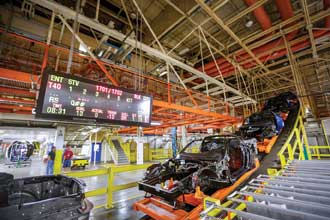
2014 Chevrolet Corvett Singray frames enter the assembly line at General Motors' Bowling Green Corvette assembly plant in Kentucky. Photo courtesy of AJ Mast; courtesy of Chevrolet.
An example can be seen in the 2014 Corvette Stingray, which is built in a General Motors assembly plant in Bowling Green, Ky. The frame of the new car is about 100 pounds lighter than its predecessor, with the reduction arising from the use of aluminum and lasers.
“When I’m laser welding some of these seams, it eliminates the requirement to seal them with secondary measures,” said Jon Andrews, the plant’s body shop tech manager. The elimination of a sealant lightens the structure; the quality of the laser joint prevents leaks.
Some of the Corvette welds are done using machine fasteners and adhesives or aluminum resistance spot welding. Lasers have an advantage in terms of weight over the first.
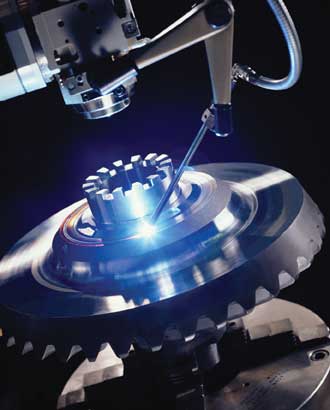
A laser welds a power train component. Photo courtesy of Trumpf.
However, laser-based techniques work best with long joint runs. “Lasers are really very fast in doing what we’re trying to do. But if we have to start and stop them a bunch, we lose that efficiency. And then the economics turn upside down,” Andrews said.
Mike Klos is general manager at fiber laser maker IPG Photonics’ Novi, Mich.-based Midwest operations, which supplies systems and solutions to carmakers. Everything in automotive manufacturing relates to time and cost, he observed.
In terms of cost, lasers offer an advantage over traditional arc welding, which works by feeding in and melting wire to join pieces together – a consumable that can become expensive when manufacturing millions of cars. Lasers also create a smaller heat-affected zone. This, in turn, helps reduce any metal expansion and distortion. As for time, a laser is capable of hundreds of welds per minute, Klos pointed out. This is possible with remote welding, where a mirror directs the beam to the spot being joined, with the laser sitting up to 20 m away. The speed with which the beam can be shifted around is set by the time needed to move a small mirror, which can be done much more quickly than moving a large robotic arm.
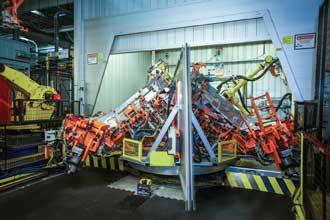
Laser booth turntables prepare for welding in the body shop at the General Motors’ Bowling Green Corvette assembly plant in Kentucky. Joe Imel; courtesy of Chevrolet.
About three out of every five applications done by IPG in its Midwest development lab involve welding. Tests show that when it comes to welding speed, more power is better – sometimes much better.
“We’re seeing in certain thin-sheet weld applications, it’s not even a linear increase. Sometimes it’s exponential,” Klos said.
Because they offer power and a good-quality beam in a compact, rugged package, he noted that IPG’s fiber lasers work better than other types of lasers when cutting thin metal sheets. The company’s high-power systems have in the past operated at about a micron wavelength. The introduction of 1.5- and 2-µm lasers will aid in the processing of polymers such as plastics, according to Klos.
The company’s line of short-pulse-width lasers can be used in material ablation, Klos added. Removing oil films, protective coatings and the like without damaging the underlying substrate is important when creating bare metal surfaces. These are needed for good electrical contact or for further processing.
Many aspects of car manufacturing
involve lasers, according to David Havrilla, manager of products and applications for the Trumpf operations in Plymouth, Mich. The company makes a range of lasers based on different technologies for various cutting, welding, surface-treatment and marking applications ranging from 16-kW CW systems to 10-W pulsed lasers.
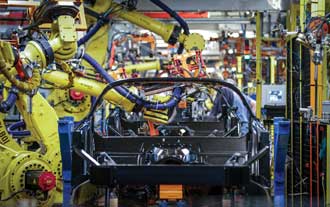
A 2014 Chevrolet Corvette Stingray frame makes its way down the composite line in the brand-new $52 million body shop at General Motors’ Bowling Green plant. AJ Mast; courtesy of Chevrolet.
For some applications, lasers are a perfect solution to a manufacturing problem. Take the cutting of hot-formed or press-hardened steel. The steel alloy, which contains boron, is heated and formed; then, while in the form, it is quickly and controllably water-cooled. The resulting parts are extremely hard, an attribute vital to important vehicle-safety features. However, the parts need to be trimmed before being used, which is difficult with conventional mechanical techniques – but not for lasers.
“[They] aren’t concerned with the hardness of the part, because they vaporize the material. We don’t care how hard the material is. It’s still steel, so it’s vaporizing at the same temperatures,” Havrilla said.
Picosecond lasers are used to ablate the coating of silicon and aluminum that encases press-hardened parts. The coating keeps the parts from oxidizing while hot, thereby preventing the creation of a layer that must be removed before painting. Welding such parts successfully, however, requires removing the coating without damaging the metal, a task a short-pulse-width laser can do with precision.
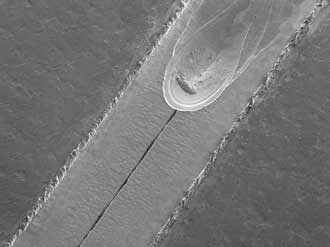
A laser-welded steel seam. Photo courtesy of Trumpf.
Such lasers have also been used to drill holes in fuel injectors in a way that cannot realistically be done using other means. The result is a reported 20 percent increase in fuel-injector efficiency.
The trend toward using lasers in car manufacturing has been pushed along by a reduction of perhaps one-third in the price of high-power, micron-wavelength CW laser systems over the past 10 years, according to Havrilla. There’s also been an increase in reliability due to fewer components, longer diode life, and the ability to remotely diagnose and fix systems. The resulting greater uptime has further improved the economics of laser-based manufacturing.
Looking forward, the emergence of higher-brightness, higher-power diode lasers should continue this trend, Havrilla predicted. Currently, diode lasers often pump other material to produce desired brightness. More powerful diode lasers will make it possible to hit the needed performance levels without a pump material. When that happens, the resulting laser will be less complex and less costly, along with having higher wall-plug efficiency.
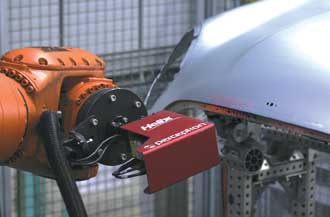
Multiple laser lines projected on a car hood allow robotic in-process dimensional measurement of the part. Photo courtesy of Perceptron.
It isn’t only in materials processing that lasers are impacting car manufacturing. They’re also showing up in measurement.
For instance, the Corvette manufacturing process announced toward the end of 2013 uses a camera system to make precise 3-D measurements of critical points of the body and thereby to verify assembly tolerances targeted to be 25 percent tighter than in previous-generation cars. “Measuring 100 points on every frame reduces the chance for unwanted squeaks and rattles,” said GM Bowling Green plant manager Jeff Lamarche.
The system doing this was designed and installed by Perceptron Inc. of Plymouth, Mich. The dimensional measurement system works by projecting a calibrated laser onto the part surface, with a camera capturing the reflected light. Knowing the geometric relationship of source to detector enables calculation of the 3-D location of part features. The sensor is mounted on the end of a robot arm, at a standoff of about 200 mm.
Overall measurement accuracy and repeatability are in the tenths of a millimeter, said Mark Hoefing, Perceptron’s chief operating officer. That performance is a function of spot size, laser power and optics, camera optics and resolution, the plant environment and other factors.
A microelectromechanical systems mirror device steers the laser spot to create lines of desired length, orientation and density on the part being measured, according to Hoefing. “This allows us to optimize the light pattern on the part for each individual measurement point,” he said.
Lasers that warm up faster and are more stable with regard to changes in ambient temperature would enhance system performance, he added. These and other improvements may be helpful in satisfying industrial customers, who ask for increasingly accurate measurement systems.
Rick Roszkowski, senior director of marketing for the vision systems unit at Cognex, noted that the Natick, Mass.-based company supplies laser profiling systems to car manufacturers for use in welding. Getting two surfaces at the proper relative height helps ensure the strongest possible weld.
“Laser profiling systems are used to detect the height of each work surface. 3-D vision tools can measure the absolute height of each surface to 20 µm in order to provide feedback to the material handling equipment,” Roszkowski said.
GM’s Andrews predicted that 3-D printing may be the next laser-based processing method to impact car manufacturing. If so, the ability to get weight out could be a driving factor.
Laser applications and usage will continue to grow for applications in auto manufacturing, he said: “They’ve increased for as long as I’ve been around it. I don’t know why that wouldn’t continue.”
Published: September 2014